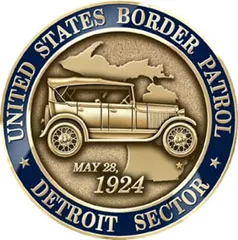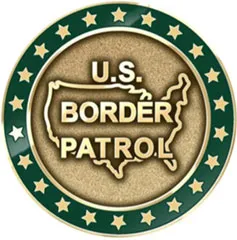The Border Patrol's fundamental mission is to secure America's borders between Ports of Entry (POEs) against all threats: terrorists and weapons, transnational criminal organizations, and illegal immigration. To meet this challenge we are continually identifying and addressing border threats using programs and techniques that are focused on applying Information, Assimilation, and Rapid Response to be more focused, effective, and efficient. The agents of the Detroit Sector are committed to working closely with the community and law enforcement organizations to keep our Nation's borders secure and safe.
History
On May 22, 1924, presumably in anticipation of passage of the Labor Appropriations Act (which established the Border Patrol), the Commissioner General of the Immigration Service announced plans to increase the Detroit District force from 18 to 40 officers and to procure patrol automobiles, boats, and motorcycles. In his announcement he specified Detroit as the most vulnerable spot to illegal entry on our borders.

In June 1924, Major Ruel Davenport was designated the first Chief Patrol Inspector in Detroit. He was given the task of organizing and directing a Border Patrol Sector that extended from Port Sanilac, Michigan to Port Clinton, Ohio. The Sector was divided into 3 sub-sectors with headquarters at Marine City, Detroit, and Sibley, Michigan. Shortly after creation of the sector, a second sector was created at Sault Ste. Marie, Michigan. This sector was to control the mounting volume of illegal entries and smuggling across the St. Mary's River between Drummond Island and Whitefish Bay, and was organized under the jurisdiction of the Immigration Service's Montreal District.
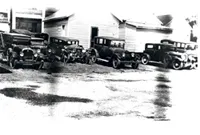
During the height of Prohibition, organized crime was a growing concern, as the Mafia controlled the majority of alcohol being smuggled into the United States. As a result, liquor smuggling from Canada became a well-organized, thriving industry. The opportunity to earn substantial sums of money became a temptation for many. Lawlessness and violence became more common along the water borders of the Detroit Sector. Three Detroit Sector Patrol Inspectors were killed in the line of duty during this period, as smugglers attempting to bring contraband across the border resorted to violence to protect their cargo.
As border violations continued to mount through the 1920's, the sector's manpower increased. By March 1926, there were 70 Patrol Inspectors and by July 1928, the total had reached 113 officers. This number represented nearly 15 per cent of the Border Patrol's 850 men nationwide. Despite all efforts, Detroit continued to have the highest incidence of illegal entry and smuggling in the country.
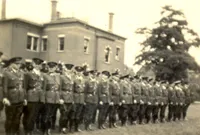
With the passage of the 21st Amendment ending Prohibition on December 5, 1933, border area traffic gradually declined. By that time, the sector force had reached a record strength of 141 Patrol Inspectors, which made Detroit the largest in the nation. This included the Sault Ste. Marie office, which had been added to the sector. In 1935 the Border Patrol received patrol boats to help control the traffic along the Detroit River, and the first Border Patrol shortwave radio was installed at Detroit in 1936. Eventually, the sub-sectors were dissolved and all operations were controlled from the one Sector Headquarters in Detroit.
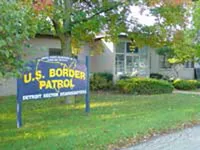
In April, 1964, Detroit Sector Headquarters was moved to new quarters on the first floor of a three-story brick building located at Jefferson and Mt. Elliott in downtown Detroit. In 1996, Sector Headquarters moved to their current location at 26000 South St., Bldg 1516 on Selfridge ANGB, Mt. Clemens, Michigan. The one-story brick building is owned and maintained by the Air National Guard.
Area of Responsibility
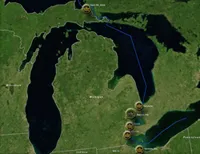
The Detroit Sector is responsible for 863 miles of international water boundary with Canada covering over 3,802 miles of lakeshores and riverbanks. The sector encompasses the states of Michigan, Indiana, Ohio, and Illinois. Michigan has 83 counties covering approximately 57,000 square miles and is surrounded by four out of the five Great Lakes (Superior, Huron, Michigan, and Erie). Additionally, Detroit Sector is responsible for Lake Saint Clair, and the Detroit, Saint Clair, and Saint Mary's Rivers.
The state of Michigan is made up of upper and lower peninsulas. The Lower Peninsula is relatively flat with a small scattering of low rolling hills. The southern half of the Lower Peninsula contains 22,000 square miles of fertile farmland and a large percentage of the state's population. Rolling hills interspersed with a few mountainous areas largely cover the Upper Peninsula. Approximately seven million acres of state and national forests cover the northern half of the Lower Peninsula and most of the Upper Peninsula.

The lakes and rivers which compose the international border in Michigan allow easy waterway access into the United States from Canada for nine months out of the year. During the rest of the year many of those waterways freeze over, impeding navigation by boat. In many places, however, "ice bridges" are created which allow for illegal crossings by foot or snowmobile.
Detroit Sector was one of the first two Border Patrol Sectors created back in 1924, the same year the Border Patrol was created. Because Detroit, MI is known as "Motor City," the challenge coin displays an American car from 1924.
